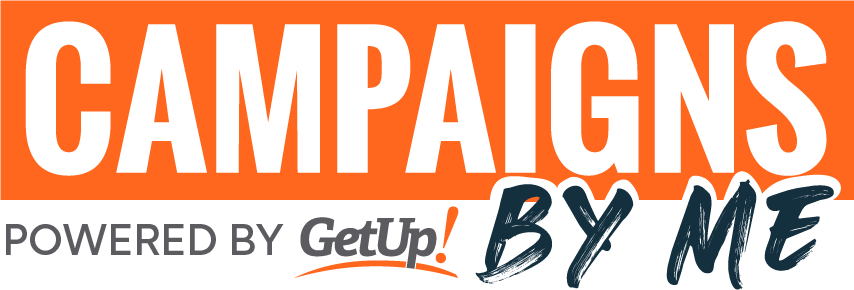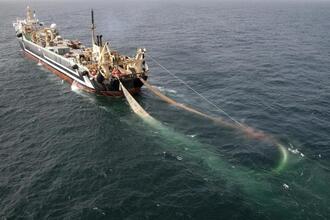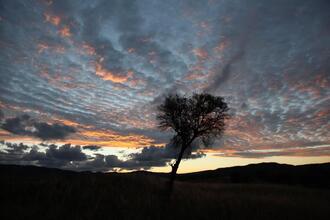-
Stop the Super TrawlerOne of the world’s biggest fishing trawlers with a history of over exploiting fish stocks, the FV Margiris, wants to trawl for small pelagic fish – some of the most critical species in our marine ecosystem. Small pelagic fishing around Tasmania already has a bad record. The surface schools of jack mackerel that were once common off southeast Tasmania have not returned after the collapse of that fishery over 20 years ago. The fish are a vital food source for important species like the critically endangered southern bluefin tuna, marine mammals, seabirds and game fish. Trawlers like this not only catch the target species, they also get tonnes of bycatch - unwanted marine life like dolphins, seals and seabirds, that gets thrown back dead. This fishing trawler is the opposite of the fishing activities we need to ensure healthy oceans and healthy communities – we need better valued seafood that doesn’t rely on government subsidies, sustainable employment for local fishermen, science based fisheries management, and no unwanted by-catch. Learn more at http://stopthetrawler.net Follow us on twitter @stopthetrawler97,292 of 100,000 SignaturesCreated by Rebecca Hubbard
-
Streamline applications for small bars in Newcastle LGANewcastle's nightlife has not undergone the same transformation as the city's dining and cultural scene. Locals and visitors to our city are limited in their options after dark and recent findings suggest most do not feel safe in the city centre at night. Small bars will give our city's nightlife the personality and vitality that it needs to move beyond a "booze barn" mentality. The City of Sydney has recorded a dramatic fall in alcohol-related assaults since supporting small bars and their working model should be appropriated by the City of Newcastle.4,465 of 5,000 SignaturesCreated by Matthew James Endacott
-
Don't build a coal mine on Queensland's Bimblebox Nature RefugeThe beautiful 8,000 hectare nature refuge named Bimblebox situated in central-west Queensland is about to get bulldozed to make way for one of the earths largest coal mines. Australia’s mining boom is creating more extensive and intrusive coal than ever before, and the majority of Australians are unaware of this reality. The "China First" project will destroy Bimblebox Nature Refuge to supply energy to Asia for the next thirty years. Locals and conservation groups have banded together to purchase the land that is Bimblebox in a bid to protect it from mining. Resisting the might of the coal industry and the political bodies that back it is a huge job for a small group of citizens; this campaign needs you and those like you to make a stand and appeal to the better sense of those that appear to forget the importance of this nations uniqueness and diversity.50 of 100 SignaturesCreated by Robyne Smith
-
Stop the closure of Commonwealth Bank branch in CoogeeAccess to physical bank services is a basic need.301 of 400 SignaturesCreated by Coogee Resident
-
No More Summer UniformIt is important because then we cannot waste half of our pe lesson getting changed, and we can be more comfy in our school day.1 of 100 SignaturesCreated by Evelyn James
-
Save COVID Care in the CommunityTHIS LIFE SAVING RURAL HEALTH SERVICE CLOSES 7 DECEMBER DUE TO FUNDING CUTS! This remote NSW health service is run by a team of nurses and doctors who monitor daily the COVID conditions of people over 70 who live alone or in remote locations. Once the patient registers their COVID positive test with Service NSW, an algorithm flags if they are in the high risk category and refers them to this service. Within 24 hours the patient receives a call from a nurse who arranges, if necessary, for a doctor to call and provide a prescription for the antiviral. The nurse continues to call the patient daily asking them to complete a survey to monitor their condition. This service has saved the lives of a number of rural people whose condition deteriorated rapidly during the week with an ambulance called by the nurse to take them to hospital. It also enables many patients to access the antiviral within the first 3 days window of infection. We are now facing another surge of infections with the Western Area COVID in the community care team doubling their number of intakes to 60 a day at the moment. HOW CAN THE GOVERNMENT PUT MONEY BEFORE LIVES AND RURAL PEOPLE'S HEALTH CARE? ESPECIALLY DURING THIS NEW SURGE WHICH WILL CONTINUE OVER THE CHRISTMAS PERIOD. IT'S JUST POLICY MADNESS!!16 of 100 SignaturesCreated by Marje Prior
-
Cancel Stage 3 Tax CutsThe govt could redirect the Money from these tax cuts to reducing the cost of living through investment in: - education (more money to public schools, fully fund pre-school for 3-5 year olds, make tertiary education free) - health (e.g. raise GP Medicare Rebate, include dental and mental health to Medicare) - aged care (e.g. increase aged care workers wages) - child care (e.g. make it free and increase educators wages) - mitigating climate change (e.g. invest in rapid decarbonisation of our economy and more sustainable farming practices) - public & social housing (e.g. build more) - indigenous issues (e.g. better funding of Closing the Gap initiatives) - raise pensions (e.g. Jobseeker, Parenting, Carer's, Disability and Aged) - Fully fund NDIS - the Arts (e.g. increase funding across Arts industries and for the ABC) Here is the parliamentary petition link: https://www.aph.gov.au/e-petitions/petition/EN44588 of 100 SignaturesCreated by Ric Benjamin
-
Ph.D Researchers are getting paid below minimum wagePh.D students do a massive amount of research and development in Australia. For Australia to remain competitive on a global scale, we need to support and encourage as many scientifically minded people to participate in research as possible. This research allows us to be at the forefront of technological advancement in a wide range of areas such as molecular science (cancer, vaccine and drug development), computer science (AI, technology innovation) and many other disciplines. Currently the legislated minimum stipend payrate for a Ph.D student is $28,854 p.a (2022 data). Most, if not all Ph.D students are only ever awarded the minimum amount or slightly higher for the duration of their degree (Often up to four years). Ph.D students have all undertaken between 4 - 6 years of previous study to begin their doctorate degree and all possess several degrees in their own disciplines. This minimum payrate needs to be increased to fall into line with the current costs of living in Australia, and at the least should be equal to or greater than the legal minimum wage. Doing a Ph.D is full time work and working weeks well exceed 40 hours. Ph.D students are highly skilled and qualified workers that are undertaking work critical to Australia to be competitive on a global stage. Lets start to support them during these formative years as Australia's young scientists and researchers and award them minimum wages at the least.1 of 100 SignaturesCreated by John Peterson
-
SBS: All programs need subtitles! ABC iView does this, why not SBS?There are plenty of old and disabled people who need subtitles on the wonderful English programs on SBS. I'm disabled and blind in the left eye and half blind in the right and I need subtitles.1 of 100 SignaturesCreated by Carol Huxley
-
Claim Back Community in ByronShort term holiday letting in residential areas is having a huge impact on communities. Many long term residents are surrounded by short term rentals which mean no consistent neighbours and loss of all that neighbourhoods have to offer. Many young people are unable to afford to buy a home in the place where they were born and their family live because short term holiday rentals have forced the price of homes out of the reach of ordinary working Australians. Many workers are unable to afford to rent near their work because of the lack of permanent rentals. Short term rentals bring greater returns to absentee landlords. Communities are suffering with the loss of permanent population influencing availability of workers, numbers of students in schools, volunteer numbers and general mental health of those who reside in communities that are consistently disrupted by partying short term renters. Having a continual turnover of strangers as neighbours is not sustainable for a community. The community of Byron Bay ask the Local and State governments to act on this issue. Ban short term holiday letting in residential areas.45 of 100 SignaturesCreated by Catherine Henniker
-
Put Gender affirming top surgery on MedicareIt’s affecting my mental and physical health, it puts me in pain everyday and it’s getting to the point we’re I can’t wear my binder for long periods of time anymore. And I don’t have the money for it2 of 100 SignaturesCreated by Jordan Hockley-Cutting
-
COVID 19 Hospital Surge Support Allowance for ALL StaffThe Victorian Government has clear guidelines for Covid 19 high-risk working areas within public hospitals. Those areas are marked as RED and Amber Zone areas. In simple terms, there is a higher risk of catching Covid 19 in those areas. But it will be only patient-facing staff who receive the surcharge, not the admin staff members who work within that area. The government also tells us that you need to work for six hours or more within those areas to be eligible for the Hospital Surge Support Allowance, but at the same time tells Victorians that it's a high risk to go and dance for an hour or attend music concerts. This policy is an apparent attempt by the Victorian Government to offer support to workers at high risk but in reality, excluding thousands of workers who work and risk their health to keep our public health system functioning. We need the Victorian Government to change this policy and make this a fair policy for all public health workers.2 of 100 SignaturesCreated by Avraham Arditi



